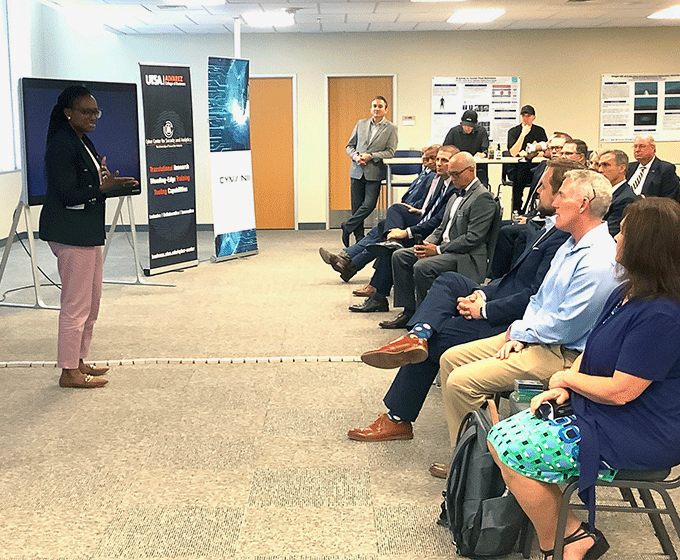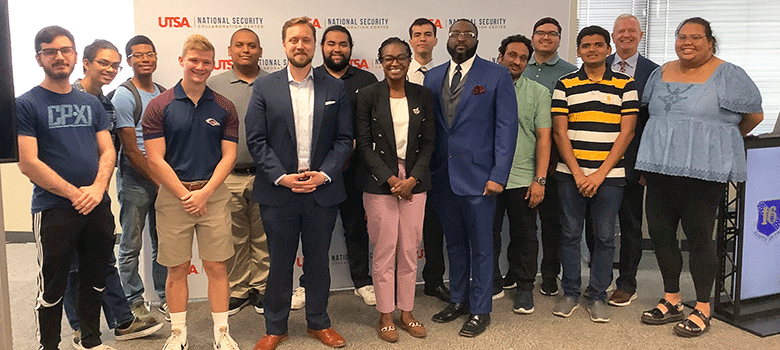
Camille Stewart Gloster, deputy national cyber director for technology and ecosystem security, speaks to a room full of attendees at an NSCC Collaboration Day event.
SEPTEMBER 27, 2022 — Senior leadership from The Office of the National Cyber Director (ONCD), residing in The White House, visited the UTSA National Security Collaboration Center this week. The delegation was invited by (Ret.) Brigadier General Guy Walsh, executive director of the National Security Collaboration Center at UTSA, to discuss priorities in the ever-evolving national security landscape. The visit was also an opportunity to showcase the research and scholarship of UTSA’s cybersecurity and national security faculty and students.
The ONCD delegation included Kemba Walden, principal deputy national cyber director; Camille Stewart Gloster, Esq., deputy national cyber director, Technology & Ecosystem Security; and Harry Kresja, assistant national cyber director for Strategy & Research.
The ONCD was established by the National Defense Authorization Act in 2021. Under the direction of John Christopher Inglis, who serves as the first National Cyber Director, the ONCD advises President Biden about cybersecurity policy and strategy, and cybersecurity engagement with industry and international stakeholders.
“ONCD’s visit to San Antonio and UTSA has been a great opportunity to highlight flagship programs and initiatives that continue to receive national recognition, demonstrating what our city and our partners have created,” Walsh said. “We are also taking them up the road to meet our research partners, and highlight the burgeoning Tech Corridor connecting the San Antonio-Austin metroplex.”

Camille Stewart Gloster and Harry Kresja from The Office of the National Cyber Director took a photo with UTSA students in attendance.
During this week’s visit, White House cybersecurity leaders met with numerous UTSA faculty and researchers as well as with federal and state leadership, including:
While visiting UTSA, there was an opportunity for the ONCD to discuss their priorities, projects and funding mechanisms. Camille Stewart Gloster was the featured speaker for the long-established NSCC Collaboration Day.
Following the ONCD presentation, Project Xander, a joint collaboration between UTSA and MITRE, was highlighted as a model for cyber in the nation.
White, alongside Bobby Blount, MITRE Texas regional innovation hub lead, Ryan Vaughn, UTSA NSCC, and UTSA students presented Project Xander, an initiative started at UTSA on campus nearly 20 years ago that has broadened with MITRE and the NSCC’s participation. As part of their coursework, students undertake cyber assessments of nonprofits and faith-based organizations’ IT systems, to mitigate cyber-attacks and avoid identify theft, ransomware attacks and other cybercrime. These student teams are mentored by local cyber experts from industry, federally funded research and development centers (FFRDC), other government organizations and academia.
MITRE has taken the program nationally and has expanded to cities outside of Texas including Huntsville, Ala.; Miami, Fla.; San Diego and Loudoun County, Va. Nationally, 45 assessment reports were done in FY22 with 37 cyber professionals representing 32 organizations in collaboration with 249 participating students.
"The overarching CIAS (Center for Infrastructure Assurance and Security) Whole-Community Cybersecurity Program project was presented during the visit, which encourages adoption of Project Xander in communities across the country. The program also includes other significant community and K-12 efforts, such as the Culture of Cybersecurity initiative, launching later this fall, and our CyBear family, introduced in 2020 which helps children as young as kindergarten age navigate cybersecurity through storytelling," explained White.
Accompanied by the NSCC, the delegation traveled to Austin and met with local representatives from the Capital Factory, DoD’s Defense Innovation Unit (DIU), AFWERX, the Army Applications Laboratory, and the National Security Innovation Council.
A Tier One research university specializing in cyber, health, fundamental futures, and social-economic transformation, UTSA is the nation’s only Hispanic Serving Institution with three National Center of Excellence designations from the National Security Agency and the U.S. Department of Homeland Security.
UTSA Today is produced by University Communications and Marketing, the official news source of The University of Texas at San Antonio. Send your feedback to news@utsa.edu. Keep up-to-date on UTSA news by visiting UTSA Today. Connect with UTSA online at Facebook, Twitter, Youtube and Instagram.
Move In To COLFA is strongly recommended for new students in COLFA. It gives you the chance to learn about the Student Success Center, campus resources and meet new friends!
Academic Classroom: Lecture Hall (MH 2.01.10,) McKinney Humanities BldgWe invite you to join us for Birds Up! Downtown, an exciting welcome back event designed to connect students with the different departments at the Downtown Campus. Students will have the opportunity to learn about some of the departments on campus, gain access to different resources, and collect some giveaways!
Bill Miller PlazaCome and celebrate this year's homecoming at the Downtown Campus with food, games, giveaways, music, and more. We look forward to seeing your Roadrunner Spirit!
Bill Miller PlazaThe University of Texas at San Antonio is dedicated to the advancement of knowledge through research and discovery, teaching and learning, community engagement and public service. As an institution of access and excellence, UTSA embraces multicultural traditions and serves as a center for intellectual and creative resources as well as a catalyst for socioeconomic development and the commercialization of intellectual property - for Texas, the nation and the world.
To be a premier public research university, providing access to educational excellence and preparing citizen leaders for the global environment.
We encourage an environment of dialogue and discovery, where integrity, excellence, respect, collaboration and innovation are fostered.